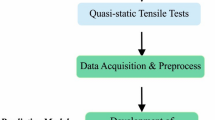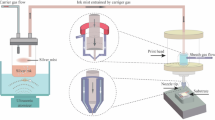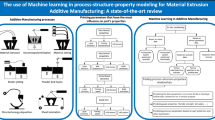Abstract
Machine learning is gaining more popularity in the FDM process in the way of performance enhancement. The multi-functionality of multi-material printing and its rising employment makes the Machine-Learning (ML) tool more attractive as the diversity of process parameters involves many fabrication combinations. This paper describes the implementation of ML techniques in the production of multi-material objects to achieve a high mechanical outcome. A nozzle temperature of PLA and ABS extruders was chosen as an input feature for ML, whereas UTS was the target. 125 samples with additional 6 pieces for deviation cases printed for 25 temperature combinations. The decision Tree model exhibited improper prediction values. Although the next Random Forest model had a fairly good R2-0.78, the 3D graph of UTS had a coarse curve. The highest R2-0.81 belonged to the 5th degree Polynomial Regression model. According to this model, to acquire the highest UTS value-41.171MPa, extruding temperatures should be 216 C, and 246 C for PLA and ABS respectively.
Access this chapter
Tax calculation will be finalised at checkout
Purchases are for personal use only
Similar content being viewed by others
References
Yong, H., Ming, L., Jyoti, M., Alkan, D.: Additive manufacturing: current state, future potential, gaps and needs, and recommendations. J. Manuf. Sci. Eng. 137, 014001 (2015)
Sathies, T., Senthil, P., Anoop, S.: A review on advancements in applications of fused deposition modelling process. Rapid Prototy** J. 26(4), 669–687 (2020)
Swapnil, V., Soham, T., Deepak, P., Shailendra, K.: A fused deposition modelling: a review. Rapid Prototy** J. 26(1), 176–201 (2020)
Rossa-Sierra, A., Sбnchez-Soto, M., Illescas, S., Maspoch, M.L.: Study of the interface behaviour between MABS/TPU bi-layer structures obtained through over moulding. Mater. Des 30, 3979–3988 (2009)
Emily, F., Ian, W., David, R., Meisha, S.:Interlayer bonding improvement of material extrusion parts with polyphenylene sulfide using the Taguchi method. Addit. Manuf. (2018)
Timothy, J., Coogan, D., Owen, K.: Bond and part strength in fused deposition modeling. Rapid Prototy** J. 23(2) (2017)
Shi, Y., Zhang, Y., Baek, S., De Backer, W., Harik, R.: Manufacturability analysis for additive manufacturing using a novel feature recognition technique. Comput. Aided Des. Appl. (2018)
**aoting, Z., **nyi, L., Athina, P., Emily, W., Charlie, C.L.W.: Perceptual models of preference in 3D printing direction. ACM Trans. Graph. 34(6), 215 (2015)
Gien, W., Nicholas, A., Timothy, S., Christopher, M.: Design repository effectiveness for 3d convolutional neural networks: application to additive manufacturing, journal of mechanical design. J. Mech. Des. 141(11), 111701 (2019)
Ugandhar, D., Shing, C.: Automated process monitoring in 3D printing using supervised machine learning. Procedia Manuf. 26, 865–870 (2018)
Guo, G., Wai, Y., Swee, S.: A review on machine learning in 3D printing applications, potential, and challenges. Artif. Intell. Rev. (2020)
Acknowledgments
This work was supported by the Faculty Development Competitive Research Grants, Ref. No. 021220FD1551, Nazarbayev University with providing experimental facilities. The authors highly express their gratitude to Nazarbayev University and Kennesaw State University for providing laboratory facilities and financial support.
Author information
Authors and Affiliations
Corresponding authors
Editor information
Editors and Affiliations
Rights and permissions
Copyright information
© 2023 The Author(s), under exclusive license to Springer Nature Switzerland AG
About this paper
Cite this paper
Ali, M., Sabyrov, N., Tanveer, M.H., Kurokawa, S., Shehab, E. (2023). Enhancing Mechanical Property of Multi-material Printed Object Through Machine-Learning. In: Kim, KY., Monplaisir, L., Rickli, J. (eds) Flexible Automation and Intelligent Manufacturing: The Human-Data-Technology Nexus. FAIM 2022. Lecture Notes in Mechanical Engineering. Springer, Cham. https://doi.org/10.1007/978-3-031-17629-6_3
Download citation
DOI: https://doi.org/10.1007/978-3-031-17629-6_3
Published:
Publisher Name: Springer, Cham
Print ISBN: 978-3-031-17628-9
Online ISBN: 978-3-031-17629-6
eBook Packages: EngineeringEngineering (R0)




